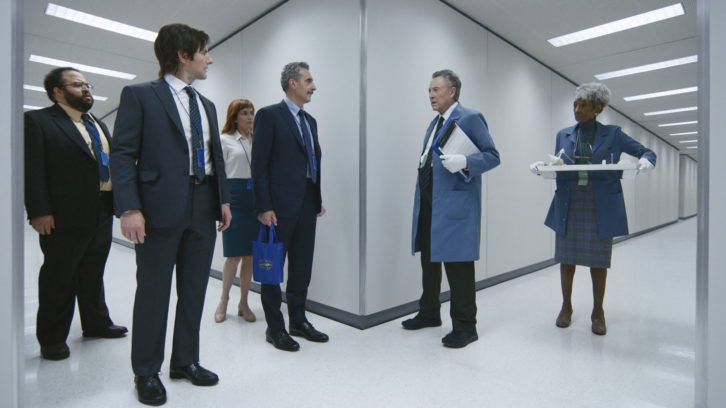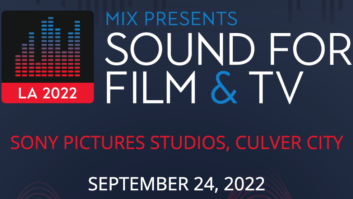
Los Angeles, CA (June 21, 2022)—The opening frame of Severance, episode 1 season 1, stays in black as a dry, disembodied voice, futzed to sound as if it is coming out of a phone or some kind of ceiling speaker, asks, “Who are you?” Long pause. “Who are you?” Nothing. Then, a quick cut to an overhead shot of a young woman lying face down on a conference room table, alone. She wakes, the camera drops down into the room as she eases off the table to check the doors, and you can see loneliness, confusion, anxiety, disorientation and panic in her face, all at the same time, as the voice asks again, “Who are you?”
From that point on, through the ensuing nine episodes of the Ben Stiller–produced (he also directed six episodes), Apple TV+ show, the visual and sonic sense inspire each other in near-perfect harmony, building from the stark, spare, quiet introduction to the, well… stark, spare and slightly louder crescendo at season’s end. Along the way, we learn about the controversial severance procedure, which essentially splits an individual’s memories in two—a working life, in this case at the sinister tech company Lumon, and a daily life outside in the world. Neither version of the individual knows of the other’s existence. Not quite dystopian, not quite sci-fi. Just quietly creepy.
Severance, sound supervised by Jacob Ribicoff and mixed in Atmos by Ribicoff (effects, BGs) and Bob Chefalas (dialog/music/Foley) on a two-position Avid S6 console at Goldcrest Post in New York, provides a stellar example of how a quiet, subtle, appropriate, yet detailed soundtrack can have every bit as much impact as a Marvel movie filled with weapons, vehicles, fights and explosions. And they are often more challenging to mix, as every sound, every note, is exposed.
SETTING THE TONE
Severance was six weeks away from principal production when the Covid shutdowns hit in March 2020. It picked up again in January 2021, under protocols, and the sound team came aboard full time in August 2021, though Ribicoff had read scripts long before and was involved in the early picture edits. The show premiered in mid-February 2022.
“We had a period at the beginning where I was able to try out all kinds of different ideas and play them for Ben and Geoffrey [Richman, supervising picture editor],” says Ribicoff. “I started playing things and the first thing they said was that everything is too loud. [laughs] Then they said that there were some interesting ideas here, but that we can’t use them in the first episode, or even the second episode. We had to start sneaking some of these sounds in as the show goes deeper and things get stranger.”
Much of the action takes place in a subterranean office complex, and most of that in the endless bright-white corridors or in the Macro Data Refining office, which is overly large in volume for the four cubicle-style desks clustered in the center of the room. With no birds, insects, winds, traffic or typical urban sounds to fill the backgrounds— only office walla, and stark, lonely walla in this case—the challenge becomes how to keep the track moving over the course of 50 minutes.
Silence is Golden in the World of High Finance
“I started thinking early on that Lumon is like this giant host, and the people working inside seem almost biologically connected to it,” Ribicoff recalls. “So I thought, ‘Wouldn’t it be amazing if there were some way, some not obvious but subtle way, to give the entire facility some kind of breathing, heart-beating feeling?’ If that was even possible? So I had this idea to make the room tones out of human breathing, and we experimented with that and came up with some tones.
“With each episode, I would sit down and say, ‘I can’t just do what I did the last episode, so what can I do to change it up?” he continues. “So for the corridors, which don’t seem very normal to begin with, I started experimenting with pitching the tones differently, using these breath-based tones. You’ll notice that sometimes when they turn a corner and the camera pans, there’s a low-end rumble slipped in, which, if I’m doing my job right, feels like a brief wave of anxiety that passes through you. That lurch in your gut.
“Then for MDR, the main room, we built out old CPUs, some 8-bit computer and videogame type sounds from the ’90s, adding the occasional hard drive lurching and going through its paces. Occasionally there’s a beep, or something that would just kind of hover at the lowest possible level, such that there were then little events within the room that could poke out.”
FOLEY MEETS DIALOG
Not every director, especially in the fast-paced world of episodics, is enamored of using Foley effects. Thankfully, Ribicoff says, Stiller, Richman and the rest of the team appreciate what the specifics and detail of well-done Foley can add to a final mix, especially a low-level, uncluttered one. On Severance, Foley was performed by New York’s A-Team of Margo Costanzo and George Lara, working out of C5.
“Nobody was happy with the footsteps in the corridors,” Ribicoff explains, noting that it was due to the resonance and reverb produced by the materials on set and not the fault of the production mixer. “We experimented with all sorts of methods, and decided to rerecord all the footsteps as dryly as possible.
Nowadays, everyone wants the Foley to sound like production, to sound live and real and all that. That wasn’t what we did, even though sometimes it can be hard to work with Foley that dry—it can sound a little weird, or too close to you. But basically for all of the scenes in Lumon, and especially in MDR, that big room with very tight carpeting, we made the Foley dry. That was a key component.”
As with Foley, editing and mixing dialog for a quiet and subtle soundtrack can be enormously challenging. Every line is the focus of the scene, so it’s even more critical that the tonality, character and depth of each line, from every actor, ring true for whatever space they occupy at the time.
“The direction was that it had to sound quiet, not big and echo-y,” says Chefalas. “Even though that room, MDR, is big, we didn’t want it to feel big. We wanted to have them sound isolated. When I listened to the production dialog, from both the live mics and the booms, the boom mics had a lot of room on them. So the trick was getting a balance between what’s live in the room and then using reverb to take some of the room out. That way I can still keep the movement and make it sound more isolated.
“Then before we started mixing, I had mentioned to Jacob that maybe I should handle the Foley, because the Foley and the production tracks were going to be so tight,” adds Chefalas, who typically mixes music and dialog only.
“As soon as I started premixing the dialog, I recognized areas where footsteps were going to be a problem. I took them out, then once we had the right type of sounds from Foley, I would add the same reverbs that I was using on the dialog side—the same settings to follow because everything is in my session.
“I’m constantly changing reverbs on the Foley depending on what room they are in,” he adds. ”For the big MDR room, I was using a reverb called Airless Room, or something like that. It’s for Dolby Atmos, and it’s a really big reverb, but it’s very tight. It adds dimension without having it sound like they’re in this big room. That’s for the dialog, then again for Foley so that they matched. When they went into a hallway, there’s a whole different reverb. In the elevator, coming out of the elevator, the reverbs were constantly changing.”
That sense of change plays a big part in filling out and driving the pace of a rich, tension-filled sound in an otherwise quiet track. And we haven’t even talked about Ted Shapiro’s sometimes traditional, sometimes quirky, jazzy score. It’s not a surprise Apple TV+ has re-upped the show for a Season 2.







